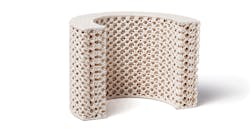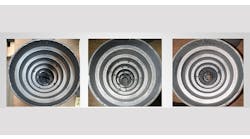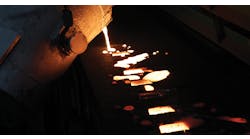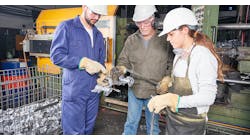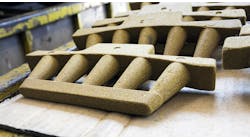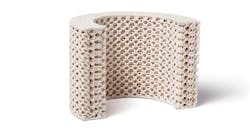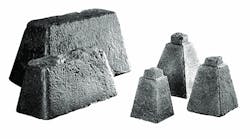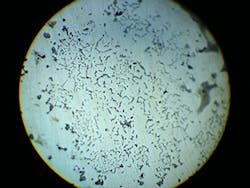Latest from Ask the Expert
At other times we find chunky graphite during the machining operations or ultrasonic testing (UT). It was suggested that we try small additions of antimony to combat the chunky graphite.
What are your thoughts on the use of antimony? What are the possible causes of this graphite degeneration and what can be done to prevent future occurrences? Are there commercially available products to address this defect?
A: Chunky graphite is an abnormal form of graphite commonly associated with heavy-section ductile iron casting(s), i.e., areas having a section thickness greater than 50 mm. These “last-to-solidify” sections of a casting are the most susceptible to this form of degenerative graphite, including the area located under a riser since this feed metal is slow to solidify.Chunky graphite is shown to have a negative impact on the mechanical properties of the iron affected. For example, the tensile properties can be reduced by as much as 22% and elongation properties can be reduced by nearly 80%. Some of the probable causes of chunky graphite can be summarized in the following:
• High-purity charge materials;
• Excessive cerium levels in the absence of tramp elements (Ti, Bi, Te, Pb, Sb and As),
• High concentrations of C, Ce, Ca, Si and/or Ni, long solidification times; and ,
• Insufficient inoculation (low nodule count).
The use of antimony will reduce the occurrence of this defect, however care should be taken when introducing antimony to your process. Small additions of antimony can promote flake graphite. Antimony is also known as a strong perlite-stabilizing element, therefore care must be taken to ensure addition rates are accurate and consideration must be given to the potential build-up of antimony in your ductile iron (returns).
In addition, over exposure to antimony dust can result in some health concerns, so care should be exercised when handling this element.
Bismuth is also an element that can be used to combat chunky graphite. Small additions of bismuth, to your ductile iron, will promote the formation of spheroidal graphite, increasing nodule count.
However, excessive additions of bismuth can result in abnormal forms of graphite, therefore it is wise to consider a balanced addition of cerium when adding bismuth to your ductile iron.
Solid cast (FeSi-based) inserts have been developed that have a balanced addition of bismuth and cerium, making this product a wise choice for increasing nodule count, thereby reducing the occurrence of chunky graphite. The SMW INSERT™ offers all the benefits of an In-mold inoculant plus protection from the costly defect know as chunky graphite. In relatively small additions (0.15%), the SMW INSERT™ will provide late inoculation that results in very little fade, and uniform-clean inoculation as close to solidification as possible.
In-mold inoculation with solid cast inserts is a mature technology that has gained wide acceptance in foundries pouring heavy section ductile iron castings. Now, there is a product that combines the ease of application- experienced with in-mold inoculation- plus the security of proper graphite formation in your heavy section ductile iron. The SMW INSERT™ comes in several different sizes ensuring the proper inoculation rate for your difficult castings. The SMW INSERT™ is now commercially available and should be tried in your foundry.
Join the Conversation. Email Your Questions for ASK Chemicals
Share your insights, opinions, and elaborate on the questions and the experts' answer(s). You must be logged in to the website in order to post your comments.
